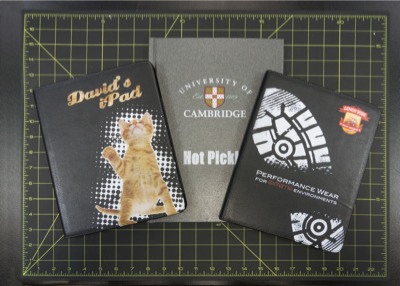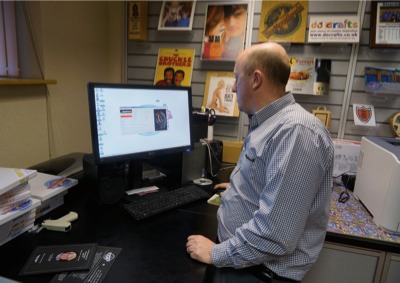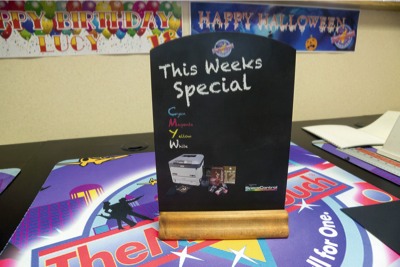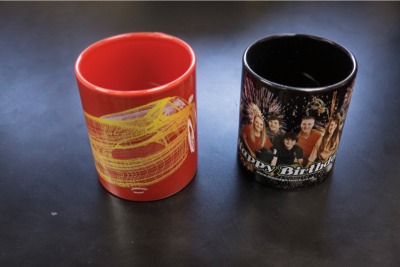Not so much a transfer paper, more a whole way of business. That is the way Jim Nicol, managing director of TheMagicTouch in Dunstable, talks about the possibilities of his company’s range of transfer papers when coupled with the so far unique white toner in a pair of low cost OKI printers. Having a white toner as an integral backing means that brightly coloured print can easily be applied to a huge range of materials, from black tee-shirts to wooden plaques and clear acrylic or polycarbonate signs.
The process is cheaper and faster than silk screening for one-offs and short runs, and simpler than twin-sheet transfer methods for applying white backings.
TheMagicTouch is an international organisation with representatives in 54 countries. It owns its own transfer paper coating facilities in Germany. The UK company has been selling transfer papers and accessories for years and has built up a marketing message around them that stresses how companies and individuals can use them to make money and promote themselves. It also sells blank materials such as tee-shirts, hats, bags, wallets, phone cases, glass and metal plaques and ceramic mugs that are suitable for its print materials.
Its Dunstable premises is full of real world examples, including any use of transfers you can think of and quite a few you probably would never have imagined. Mr Nicol talks constantly of ways for users to promote and market themselves with these materials – either selling them as finished goods, such as tee-shirts, work wear, mugs, signs and so on, or as items for printers in particular to promote their own businesses and get a foot through the door to sell other things.
Transfer papers that can be printed in low cost toner printers have been available for years, with the image being then applied to a final object using a heat press. These are typically used for garments such as tee-shirts, work wear, hats, wooden plaques and signage. There are also dye sublimation transfers that can be used with polyester fabrics as well as polyester coated mugs and the like.
TheMagicTouch CPM is its general purpose heat transfer paper for hard surfaced materials, plus ORD for glass and acrylics. It also has TTC for white textiles and OBM for coloured textiles.
The challenge has been how to transfer onto black or strongly coloured fabrics or other substrates, where normal CMYK toners are not strong enough to show up. Several companies have developed a two-sheet process that puts a white base layer between the substrate and the coloured transfer image, so the colours show up as intended.
WoW! is TheMagicTouch’s two-sheet solution for black fabrics. With standard toner printers the sequence is fairly complex, necessitating the creation of a printed black-only negative sheet which is heat-transferred to the white ink ‘M’ mask sheet, then peeled off to leave a white base layer. The coloured image is printed on a second sheet (called the ‘I’ sheet), then the white mask image is then heat transferred on top of that (using manual alignment, though you can print registration marks and tape the sheets together on a light box). The M sheet backing layer is peeled off, leaving the white layer face up. Finally the complete image is heat transferred onto the substrate, white-down.

The new OKI C711WT (A4) and C920WT (A3) printers simplify that, as they print the white in the same pass as the colours. The A4 printer costs about £2000 and is suitable for the majority of transfer work, according to Mr Nicol. The A3 printer costs around £6000. A large image on a tee-shirt might need this area, but Mr Nicol expects most users to choose A4. ‘You can buy a £2000 printer and a heat press and be up and running for about £3000,’ he said. ‘Say a salesperson earns £40,000 per year. For another £3000 you can attract your customers’ attention before going in with a follow-up call.’
Because the WT models print the white toner last, it forms a base layer when transferred face down onto the final substrate. However, this won’t work for printing directly onto the final media such as coloured or black card, or when creating water slide decals, as the white needs to be applied first.
According to Nathan Newbury, head of technical at TheMagicTouch, the answer here is to print a double pass, with white only as the firstpass, and the second pass to put CMY on top of that. This can be set up by the SpaceControl RIP software that TheMagicTouch supplies with the printers. This might not work for close register work, but normally the base white will not need that.

‘We give away our SpaceControl RIP software with every printer, and this controls the white image,’ said Mr Nicol. ‘Our colour management system also controls the threshold and density of the white. For something like black leather, it needs a very high density. We can go right up to 400% white to get it very dense. The biggest problem has been gradients, for instance red to white. We can adapt the threshold to control where the white appears in a gradient. We also control the densityof the white.’
However, for black tee-shirts and similar garments, which Mr Nicol called ‘the holy grail’ of transfer work, the OKI white toner is still not dense enough. In that case new WoW! 7.5 sheets are used to give the densest possible white, but with a simplified two sheet workflow that doesn’t need the printed black mask sheet. The I sheet is printed with CMY+White in the OKI and then the white M sheet is heat transferred onto that. When the M backing sheet is peeled off, the WoW! white layer adheres to the OKI white toner, boosting the density. The I sheet is then heat transferred onto the fabric.
‘The printer works at 30 sheets per minute, so the bottleneck becomes the heat presses,’ he said. ‘Some clients have four of these to keep up. Not many customers want a run of 1000 shirts, but a lot will want 25 to 30 for tomorrow or the day after that.’
‘There are many commercial applications from printers, graphics shops, copyshops, but many of them are poor at publicising what they can do,’ he states. ‘If you send a mug or a tee-shirt to a customer or prospect, it’s an opportunity to then pick up the phone and say ‘did you like it and how are you doing?’ Having equipment and premises means nothing without customers; this is the tool that can help them.’
So for commercial printers, this is a marketing tool that can also be used to make print-for-pay jobs, he said. ‘But we also have people workingfrom home, as their whole business. They have low costs but they are hungry for work. I had one customer who went to a local gym with a logo on an iPhone cover. This got him orders for more iPhone covers, but also all the gym’s tee-shirts. Another customer in Scotland turns over £200,000 from a cabinin his garden. There is real profit here. Printers can make money with this. Some of our customers drive Ferraris!’
Mr Nicol sees the showroom, the ideas for applications and the training, as all part of the service to his customers, which in turn leads to more sales of his prime product, the transfer papers. ‘For instance, I showed samples of white print on black paper for orders of service, to two or three UK associations of funeral directors, and the Co-op. It took a while to find a black paper that would work properly. I’m not interested in selling directly to funeral directors, but I’ll sell to printers who want to sell to funeral directors.’ He also shows off painted blackboards for restaurant menus, with coloured text and logos from the transfers.

‘The idea of transferring onto difficult surfaces, colour etc, as one-offs, is very interesting,’ he enthuses. ‘There’s also the market for work wear, which is phenomenal. Joggers, bikers, all want the right gear, with high performance fabrics. Nearly all niche sports and hobbies now have specialised garments and these need branding. Now we can print on anything – nylon, cotton, leather, denim, hi vis, you name it.





